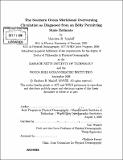| dc.contributor.advisor | Carl Wunsch. | en_US |
| dc.contributor.author | Mazloff, Matthew R | en_US |
| dc.contributor.other | Woods Hole Oceanographic Institution. | en_US |
| dc.date.accessioned | 2009-06-30T16:17:17Z | |
| dc.date.available | 2009-06-30T16:17:17Z | |
| dc.date.copyright | 2008 | en_US |
| dc.date.issued | 2008 | en_US |
| dc.identifier.uri | http://hdl.handle.net/1721.1/45781 | |
| dc.description | Thesis (Ph. D.)--Joint Program in Physical Oceanography (Massachusetts Institute of Technology, Dept. of Earth, Atmospheric, and Planetary Sciences; and the Woods Hole Oceanographic Institution), 2008. | en_US |
| dc.description | Includes bibliographical references (p. 115-127). | en_US |
| dc.description.abstract | A modern general circulation model of the Southern Ocean with one-sixth of a degree resolution is optimized to the observed ocean in a weighted least squares sense. Convergence to the state estimate solution is carried out by systematically adjusting the control variables (atmospheric state and initial conditions) using the adjoint model. A cost function compares the model state to in situ observations (Argo float profiles, CTD synoptic sections, SEaOS instrument mounted seal profiles, and XBTs), altimetric observations (ENVISAT, GEOSAT, Jason, TOPEX/Poseidon), and other data sets (e.g. infrared and microwave radiometer observed sea surface temperature and NSIDC sea-ice concentration). Costs attributed to control variable perturbations ensure a physically realistic solution. The state estimate is found to be largely consistent with the individual observations, as well as with integrated fluxes inferred from previous static inverse models. The transformed Eulerian mean formulation is an elegant way to theorize about the Southern Ocean. Current researchers utilizing this framework, however, have been making assumptions that render their theories largely irrelevant to the actual ocean. It is shown that theories of the overturning circulation must include the effect of pressure forcing. This is true in the most buoyant waters, where pressure forcing overcomes eddy and wind forcing to balance a poleward geostrophic transport and allows the buoyancy budget to be closed. Pressure forcing is also lowest order at depth. Indeed, the Southern Ocean's characteristic multiple cell overturning is primarily in geostrophic balance. Several other aspects of the Southern Ocean circulation are also investigated in the thesis, including an analysis of the magnitude and variability of heat, salt, and volume inter-basin transports. | en_US |
| dc.description.statementofresponsibility | by Matthew R. Mazloff. | en_US |
| dc.format.extent | 127 p. | en_US |
| dc.language.iso | eng | en_US |
| dc.publisher | Massachusetts Institute of Technology | en_US |
| dc.rights | M.I.T. theses are protected by
copyright. They may be viewed from this source for any purpose, but
reproduction or distribution in any format is prohibited without written
permission. See provided URL for inquiries about permission. | en_US |
| dc.rights.uri | http://dspace.mit.edu/handle/1721.1/7582 | en_US |
| dc.subject | Joint Program in Physical Oceanography. | en_US |
| dc.subject | Earth, Atmospheric, and Planetary Sciences. | en_US |
| dc.subject | Woods Hole Oceanographic Institution. | en_US |
| dc.subject.lcsh | Ocean circulation | en_US |
| dc.subject.lcsh | Ocean temperature | en_US |
| dc.title | The southern ocean meridional overturning circulation as diagnosed from an eddy permitting state estimate | en_US |
| dc.type | Thesis | en_US |
| dc.description.degree | Ph.D. | en_US |
| dc.contributor.department | Joint Program in Physical Oceanography | en_US |
| dc.contributor.department | Woods Hole Oceanographic Institution | en_US |
| dc.contributor.department | Massachusetts Institute of Technology. Department of Earth, Atmospheric, and Planetary Sciences | |
| dc.identifier.oclc | 318650787 | en_US |
